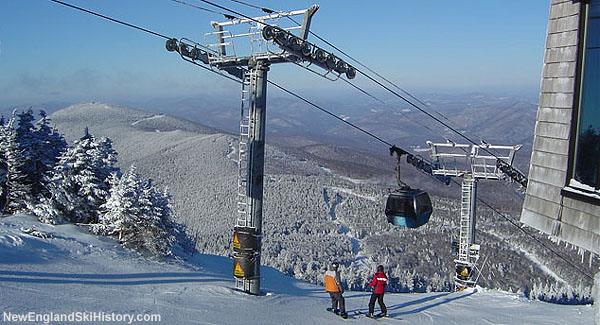
|
| Killington |
| Killington, Vermont |
| Status: |
Open
|
| First Season: | 1958-59 |
| Vertical Drop: | 3050 feet |
| Standing Lifts: | 2 gondolas, 2 six packs, 4 high speed quads, 4 quads, 3 triples, 1 double, surface lifts |
| Past Lifts: | 1 gondola, 1 high speed quad, 3 quads, 2 triples, 9 doubles, surface lifts |
| Left: The K1 Gondola (2005) |
| Recent NewEnglandSkiIndustry.com News:
|
| 10/17/2025: Killington To Replace Snowdon Triple Nex... | | 8/27/2025: August 2025 Lift Construction Roundup | | 5/10/2025: Chairlift-Served Ski Season Ends Tomorro... | | 11/13/2024: Ski Season Resumes Tomorrow |
 |
|
At 4,235 feet in elevation, Killington Peak is second highest peak in Vermont, as well as one of the highest in all of New England. Killington Peak is best known as being home to Killington Resort, which is by many measurements the biggest ski area in the Northeast.
Killington Peak
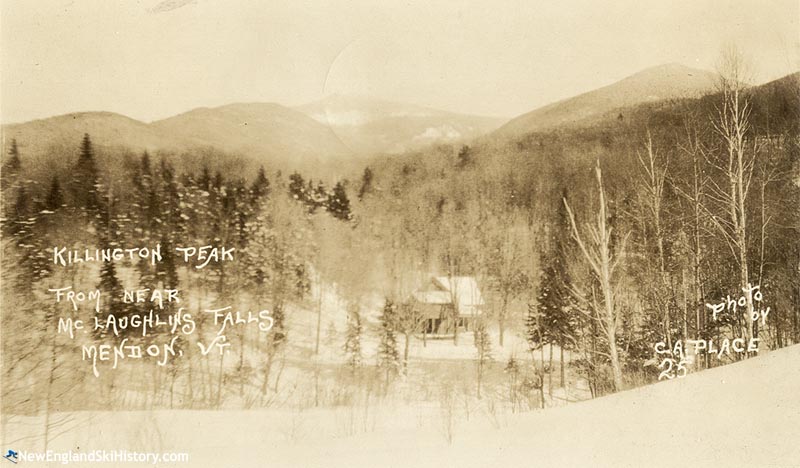
An early photo of Killington Peak |
Thanks to its commanding appearance and proximity to Rutland, Killington Peak was a recreational destination dating back to colonial American history. In July 1879, a carriage road was constructed up the western face of the mountain, leading to the opening of a near-summit hotel by M. Meyerhoffer in 1880. Initially quite popular, the building was expanded in 1882. According to Killington: A Story of Mountains and Men, an electric railway up the mountain was proposed later that decade. The hotel and summit parcel were sold to Marcellus Wheeler in 1901. By the time 1907 rolled around, reservation requests to stay at the hotel were denied, with the owner claiming they could not find an operator. The hotel and carriage road quickly deteriorated.
The earliest known ascent of Killington Peak on skis occurred in February 1917, when a group of Green Mountain Club members ascended the mountain on a particularly cold day. One of the two skiers in the group was Charles P. Cooper, who led additional winter ascents of Killington while serving as president of the Green Mountain Club. By this point, the hotel was no longer standing.
Future Governor Mortimer Proctor purchased the Killington summit tract from Wheeler in 1919. In 1927, the ridge that Killington Peak topped was named the Coolidge Range in honor of President Calvin Coolidge, who grew up in nearby Plymouth. Coolidge was quoted as saying, "Vermont is a state I love. I could not look upon the peaks of Ascutney, Killington, Mansfield, and Equinox without being moved in a way that no other scene can move me."
In the mid-1930s, Killington was chosen by the National Park Service as part of the route for the proposed Green Mountain Parkway. The bold proposal did not come to fruition.
For the winter of 1935-36, a ski development was constructed in the vicinity of nearby Shrewsbury Peak, including a rope tow and multiple trails.
Following the death of Charles P. Cooper in 1936, the Green Mountain Club proposed the construction of a lodge in his honor. Mortimer Proctor deeded a parcel of land to the state for the building, which was to be constructed near the site of the former hotel. Construction stretched over multiple years, as many roads were washed out by the September 1938 hurricane. State and Civilian Conservation Corps labor were also used in the construction, which was led to completion by state forester Perry Merrill. The Cooper Lodge was dedicated on Sunday, June 2, 1940.
Meanwhile, a lift-served ski development debuted on Little Pico for the 1937-38 season, adding a major T-Bar lift in 1940.
Circa 1941, the Vermont Forest and Parks Department reportedly put together plans for a ski area on Killington Peak. One of the earliest known public proposals to develop a lift served ski area on Killington occurred in 1944, when sketches of a ski area on the east side of the mountain were presented to local chambers of commerce. Talk was still circulating in late 1946, however two major impediments were a lack of an access road into the basin and concerns about hurting Pico's business. Circa late 1945, the State of Vermont reportedly acquired the Killington tract of land.
Preston Leete Smith and the Sherburne Corporation
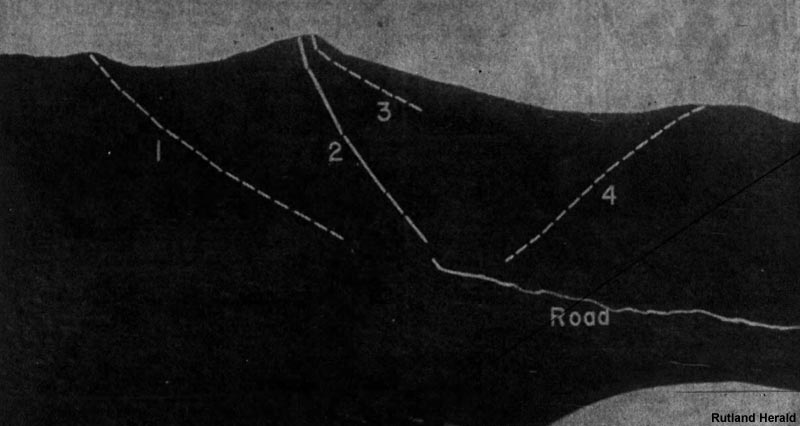
1956 Killington Proposal |
The ski industry to continued to pass Killington by as a young Preston Leete Smith graduated from the Oakwood Friends School in 1948 and Earlham College in 1952. In the fall of 1954, Smith reportedly met with Perry Merrill and discussed purchasing Ascutney. Merrill persuaded Smith to instead look into developing a ski area on Killington Peak. Smith and Susanne Hahn were married in 1955 and began spending more time at his parents' home in Rockingham, Vermont, soon moving in with his grandparents. Smith spent considerable time on the mountain during the winter of 1955-56 inspecting terrain and snow depths.
Smith looked to build a ski area larger than Stowe on Killington Peak. According to Killington: A Story of Mountains and Men, around this time he met Joe Sargent, an investor in Mount Snow, who talked Smith down from initial plans of a cabin lift and three mountain peaks to a smaller upstart that could be more easily financed. The Sherburne Corporation was formed in April 1956. In early May, reports emerged that construction would soon begin and that the area could be in operation for the winter of 1956-57 with a lift, two trails, and temporary buildings. Smith estimated that some 150 acres of gladed terrain were already skiable.
The Sherburne Corporation held an event for potential out-of-state shareholders in late May 1956, when natural snow was still reported to be hanging on in places on the mountain. An agent from the Pomalift company showcased his company's lift technology, while the Sherburne Corp. discussed on-going work on the construction of an access road.
Smith's lift plans emerged in the summer of 1956, calling for a chairlift to the summit, an upper mountain Pomalift, and top-to-bottom Pomalifts on Snowdon and Skye Peak. The project made the Associated Press wire in July, as an off-beat news story involving porcupines caught the attention of readers. Crews working on the mountain reported that porcupines had been chewing on tires, rubber ignition wires, and even an aluminum skillet.
The project was dealt a blow in late 1956, when the State Highway Board announced there were no funds to construct the estimated $300,000 to $400,000 5-mile access road to the proposed ski area. The board suggested the issue would have to go to the legislature.
In April 1957, the state legislature appropriated $750,000 to construct access roads for Killington, Okemo, Burke, and Jay Peak. Two months later, the legislature approved $30,000 to construct a base lodge at Killington. The Sherburne Corporation proceeded with construction of the ski area, employing a crew of 15 to 17 men. Though the highway department completed a survey, it announced later in the summer that it would not construct the Killington access road in 1957 and that the estimated cost of the project had ballooned from $140,000 to $310,000.
In mid-November 1957, the Sherburne Corporation finally reached terms for a lease with the state. Terms for the initial 10-year lease included the state receiving 10% of annual revenue above $40,000. Despite being unable to open due to the access road situation, the Sherburne Corporation took delivery of the lower Snowdon Pomalift.
Killington Basin Opens
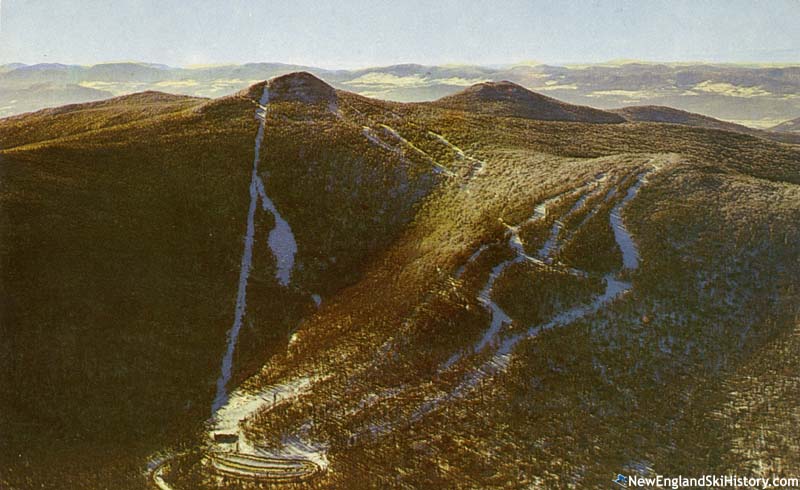
Killington Peak circa 1960 |
In April 1958, Preston Smith formally announced that Killington would open for the 1958-59 season. The state finally started constructing the 4.4 mile access road on May 5 while Sherburne Corporation crews worked on clearing trails and lift lines on Snowdon.
In August, the Sherburne Corporation took delivery of the upper Snowdon Poma as it began pouring tower footings for the lifts. As September arrived, the state began constructing the access road surface, using soil cement, asphalt, and blacktop layers. According to Killington: A Story of Mountains and Men, at this time the Sherburne Corporation had 94 shareholders, most of them residing in Vermont.
Construction continued to gain momentum as the fall arrived. In addition to trail and lift construction, the 6,000 square foot state base lodge was being built. With a work road now extending to the top of the mountain, Smith announced a third Pomalift would be constructed for the 1958-59 season, serving the Glade area. A forth Pomalift would serve a novice slope.
Amidst prime leaf peeping season, a dusting of snow covered the summit of Killington on October 12, 1958, foreshadowing ski season. The Rutland Herald declared it "more than a prophecy - it signaled the beginning of a multi-million dollar winter business which, here in Vermont, will provide countless hours of healthful pleasure to equally countless numbers of skiers." Paving of the access road was completed at the end of October.
The state advertised for a lodge operator in October and received only one bid: the Sherburne Corporation.
In early December, the Sherburne Corporation announced opening day would be December 13 and that up to seven miles of trails would be available, served by four lifts. Future plans of four more Pomalifts and two chairlifts were announced, with an expansion to Skye Peak expected for the 1959-60 season. Governor-elect Robert Strafford cut the ribbon for the formal opening, which featured the two Pomalifts on Snowdon and base depths of 20 to 36 inches. According to Killington: A Story of Mountains and Men, Killington recorded $25.50 in opening day ticket revenue.
Construction continued as the 1958-59 season progressed, with the novice Pomalift debuting in mid-January. Robert Van Beever, previously serving as director of the Snow Valley ski school, was named head of the Killington Basin Ski School and area manager. Born in Indonesia, Van Beever was reportedly raised in Austria and Germany, became an American citizen in 1949 or 1951 (accounts vary), served in the Air Force Intelligence Service during the Korean War, reportedly served in the CIA thereafter, and was a member of the United States Air Force and Heidelberg University ski teams.
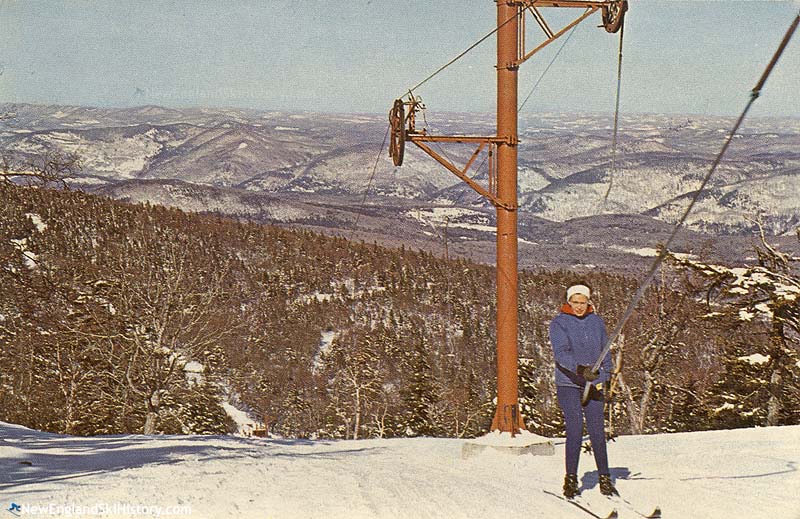
The Glades Poma circa the 1950s |
Though the Glade Pomalift was also nearing completion, a January thaw wiped out much of the mountain's base, slowing the opening of the new lift. The Glades Pomalift finally opened in mid-February, serving East Glade, West Glade, Rim Run, and Killink. Now advertising the highest lift-served skiing in the state, Killington's popularity soared, averaging 1,000 skiers per day over Washington's Birthday weekend.
Meanwhile, Preston Smith and Killington had become prominent enough to be targetted in a forged check ring. At least thirteen men were charged with passing fake Killington National Bank checks throughout the region using Smith's name.
In mid-March, Killington hosted the 11th annual Walter Foley Memorial Trophy collegiate race, which was won by MIT. On March 24, Robert Van Beever was approaching the Snowdon mid-mountain trail junction (later nicknamed Van Beever's Corners) with Billy Briggs and Joe Jones when he slid off the trail and snapped four leg bones. Though amputation was avoided, the severe injuries nevertheless ended Van Beever's skiing career.
The Killington Chairlift
That spring, Killington announced it would continue daily operations through April 19. The area nearly made its goal, shutting down on April 16 after warm weather zapped the snowpack. Meanwhile, the company announced it would be installing a chairlift on Killington Peak, to be topped with a summit restaurant.
In September 1959, Killington hosted the New England Field Archery Tournament, which had 607 contestants. An area near Pres Smith's house served as a campground for hundreds.
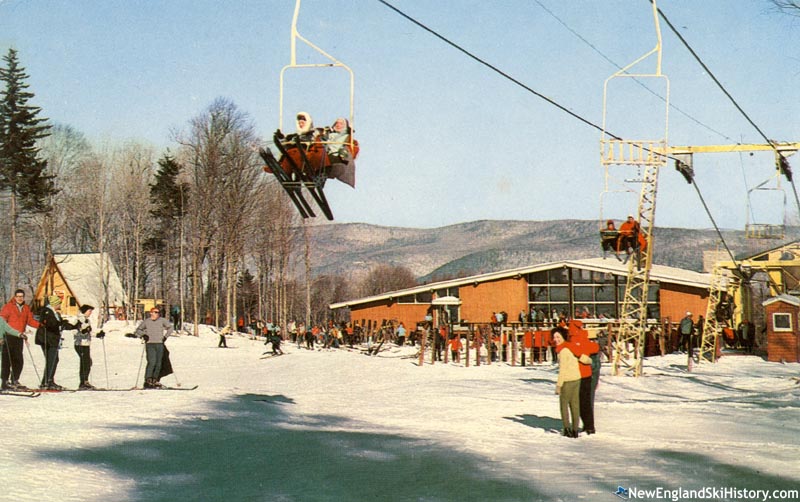
The Killington Chairlift (1960s) |
The new chairlift was advertised in advance of the 1959-60 season with a mid-December estimated completion date. The lift was described in the Rutland Herald as a "Poma-Telecar chairlift" that was "engineered and fabricated by Dr. F. Savio, designer of gondola lifts, and J. Pomagalski, producer of Pomalifts." Goat Path and Cascade were cut from the top of the new chairlift, while Great Bear was completed on Snowdon. Complementing the new terrain, a two-story base lodge was built with a cafeteria and lounge on the upper floor and a ski shop, patrol, and ski school headquarters in the basement. Meanwhile, Pres Smith's uncle Preston Leete took over as general manager of Burke Mountain.
Killington picked up a few inches of snow in late November, but it wasn't enough to open. The season finally kicked off in mid-December on a few inches of base, but without the new chairlift. The "skimpy snow cover" and lack of chairlift service were compounded by the closure of the Snowdon Pomalift due to a cable problem on the day after Christmas, resulting in a hurried overnight splicing project to get the area open again. Natural snow arrived soon thereafter, giving Killington a strong New Year's holiday. The boost was short-lived, as a large rain storm hit the area a day later and the Glades Pomalift motor failed. The Rutland Herald noted that, "Many skiers went to Killington expecting to find the chair lift in operation as advertised and were disappointed to find how far it was from completion."
Chairlift towers began to rise as January drew to a close. Even without the lift, business ended up 300% over the previous season. The lift finally opened to the public on April 2, operating at reduced speed while adjustments were made. The Cascade trail was not open, so skiers could only take Goat Path to the existing Glade complex. The first full day of operations was on April 3 with "miserable weather" as the Rutland Herald added, "How much longer the cover can stand up under the current downpour is not known."
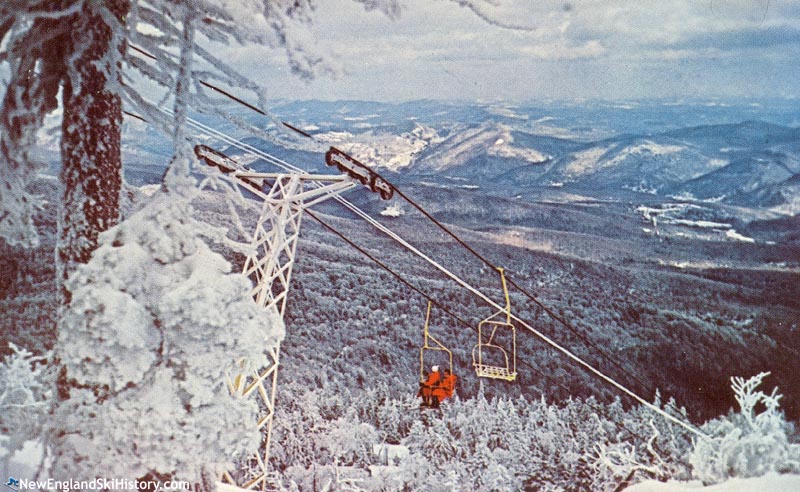
The Killington Chairlift (1960s) |
On April 10, 1960, Governor Robert Stafford and Lieutenant Governor Robert Babcock dedicated Killington Basin at the base lodge and subsequently road the chairlift and skied down. The season came to a close a few days later. In just its second year of operation, Killington turned a profit.
Off-season operations began at the end of May 1960, as the new chairlift operated for scenic rides in conjunction with the base area restaurant and gift shop. In July, Killington installed two gondola cabins on the double chairlift to augment the sightseeing business, stopping the lift when the cabins arrived at each terminal. In addition, a small pond was dug adjacent to the base lodge to improve the aesthetics.
Cat Walk, East Fall, and Skidway were added for the 1960-61 season, while existing trails were smoothed and hayed and the parking lot enlarged. Access to the ski area was improved with the completion of the three-lane US 4 highway from Mendon to Sherburne Pass. Meanwhile, the state executed a new lease agreement with Killington, changing the payment from 10% of lift gross above $40,000 to 5% of lift gross and 2.5% of food and retail gross.
Following a fluke storm in late October, Pres Smith invited skiers to hike up and ski seven inches of new snow, adding that lifts would start spinning as soon as Thanksgiving. The October snow melted as it always does, leaving Killington's slopes idle until mid-December, when the area opened the novice lift with poor conditions. A foot of snow fell just before Christmas weekend, opening all lifts.
Paul Bousquet was named operations manager in December 1960. Prior to working at New Jersey Bell Telephone, Bousquet had operated his family's Bousquet ski area in Massachusetts.
A New Year's weekend snow storm further boosted business, resulting in a crowd of over 2,000 on the observed holiday. By early February, Killington was reporting base depths of one to four feet. However, by Washington's Birthday, mild weather and rain resulted in poor top to bottom conditions with bare spots, closing Cascade and East Fall. Nevertheless, unlike some other ski areas in the region, Killington remained open.
Meanwhile, Sherburne Corporation stockholders voted to double the number of available shares and authorize stock options as the company looked to expand the ski area. Immediate expansion proposals included two new trails and a new summit shelter, while plans were made to construction a novice area along the access road, a chairlift on Snowdon, and a chairlift and trails on "North Peak."
Conditions marginally improved at the start of March 1961, with the area advertising a 7 to 15 inch base for intermediate and expert skiers only. The snowiest part of the season ended up being mid-April. Killington offered skiing in May for the first time that spring, as the month started with more fresh snowfall. Within a week, however, the season came to a close and temperatures abruptly soared into the 80s. Whereas many other ski areas in the state saw decreased business during the winter of 1960-61, Killington saw attendance increase by more than 70 percent. Operating 145 consecutive days, Killington claimed the title of "longest continuous operating schedule in the Eastern United States," which became a cornerstone of the business.
Snowshed
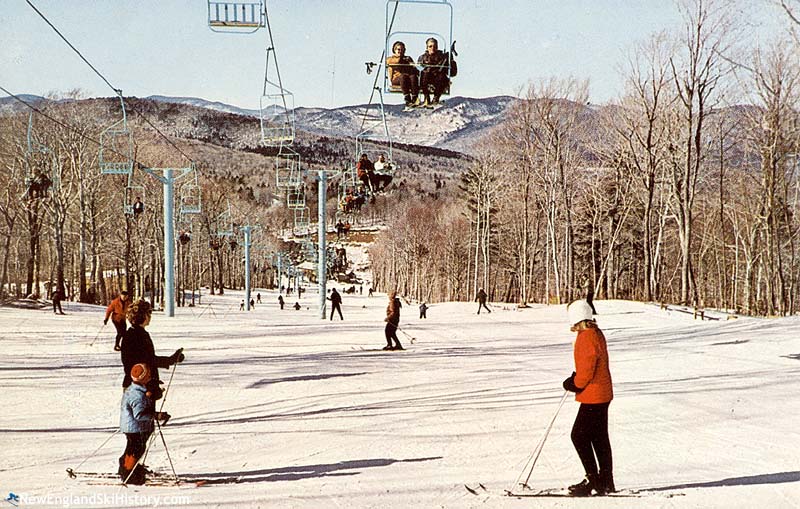
Snowshed (1960s) |
Clearing of the new Snowshed area began in late May while production began for a new Poma chairlift. While specialized parts came from France, the towers were fabricated at Vermont Structural Steel Co. The lift was reportedly over-engineered so that some parts could be used interchangeably with the summit chairlift. That summer, some of Sherburne's bicentennial activities were held at the ski area.
In addition to the Snowshed project, other 1961 enhancements included the installation of a second novice Pomalift on the main mountain, and the extension of three-phase electric to the ski area.
The Killington Klimb race was held on the upper portion of the access road in October, hosted by the Killington Sports Car Club. The race was won by Bob Hoffer, whose T-Bird averaged 88 miles per hour.
On November 1, 1961, the name of the Sherburne Center Post Office was changed to Killington Post Office. According to the Rutland Herald, the renaming "ended a long period of confusion between 'Sherburne' and 'Shelburne' in this state" while also recognizing the impact of Killington Basin to the area.
Work was still underway on the new Snowshed area as snow ushered in Thanksgiving. The complex featured four trails and a double chairlift, as well as a 250-car parking lot. A building used for the town's bicentennial celebration was repurposed as a warming hut. Additional snow during fell the following week, enabling main mountain operations to start during the first weekend of December, Killington Basin's earliest start yet. Snow continued to accumulate, rolling into Christmas with one to three feet of base. The Snowshed area reportedly opened that week.
Meanwhile, racing was continuing to grow in popularity at the resort. December 1961 race training included coaching from prominent skiers such as Joe Jones, Monk Martin, Verne Goodwin, and Norm Letarte. Two up-and-coming racers from the area around this time were Suzy Chaffee and her brother Rick Chaffee.
John Polando took over as ski school director for the 1961-62 season. Polando has previously held that title at Boston Hill.
January 1962 started off strong, however a mid-month thaw resulted in poor conditions and event postponements. Killington nevertheless remained in operation when other areas had to shut down. Skiing was limited and icy until a foot of snow arrived at the end of the month.
In early February, Killington held Appreciation Days, providing free skiing for Vermont residents. Pres Smith reasoned, "we feel Vermonters should have an opportunity to visit us to see what we are and how we have added to the wealth of our Community of Sherburne, surrounding towns, and the State of Vermont."
Once again, the ski season was redeemed with March snowfall, as base depths reached roughly 3 to 7 feet by the end of calendar winter.
As temperatures reached the upper 70s in Rutland, Killington recorded 2,000 skier visits over Easter weekend in April 1962. The season melted out just short of May. Business was reportedly up by 89% over the previous season.
Ram's Head
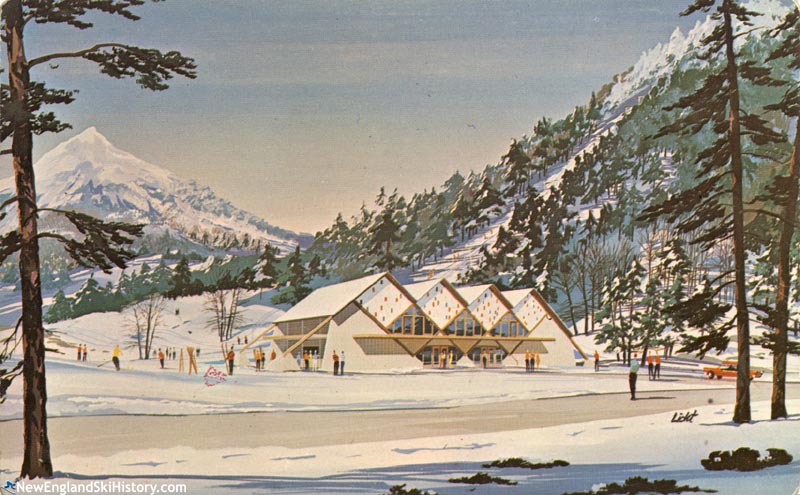
A rendering of the Rams Head base area |
In April 1962, the Sherburne Corporation announced it would be building yet another trail complex. Initially named North Peak, the complex was designed to serve the fast-growing intermediate skier market while increasing the reported size of the overall ski area by 30 percent. A 1,400 vertical foot double chairlift and a 100 foot by 40 foot base lodge were planned.
In late May, Phillip Camp was named public relations manager, as Killington continued its ascendency into being one of the best-known ski areas in the region.
A June 1962 update declared the North Peak expansion to be on schedule, with the lift line fully cut and half excavated. Lee Ward was hired to handle trail clearing, sending valuable lumber to the sawmill and cord wood to his firewood enterprise. Meanwhile, Gardner Taylor, described as "a dynamite expert," was hired to blast and widen Goat Path from the top of Killington Peak.
The Killington Chairlift continued to operate on a scenic basis during the 1962 off-season, with the company offering free rides to girl scouts, locals, and other parties in conjunction with events. The area also hosted its third annual Killington Green Mountain Boys muzzle loading competition.
In September, Preston Smith announced that Karl Pfieffer had been promoted to ski school director, remarking, "His addition will greatly assist us as we commence operation of the 'new Killington.'" A native of Austria, Pfieffer had immigrated to the United States in 1958, studying business in Boston and becoming assistant director of the ski school.
By November, the North Peak project had been renamed Ram's Head. Providing a "striking second base lodge," the four new novice and intermediate trails allowed skiers to "circle the entire basin area," and gave Killingon the claim as the third largest ski area in the state, behind Mt. Mansfield and Mt. Snow.
Though Killington had planned on starting the season in early December, a lack of snow forced the postponement of a planned US Eastern Amateur Skiing Association race. A snow storm finally allowed the area to open the Glades Pomalift via the Killington Chairlift on Sunday, December 9, with lower mountain terrain opening soon thereafter. The race was held on the following Sunday on Upper Cascade, with Rebel Ryan beating Bill Kidd, Warren Witherell, and Rick Chaffee by more than half a second for the victory. Killington recorded 2,000 skiers that weekend, cramming the base lodge due to Rams Head still being under construction.
In January, ABC's Discovery '63 children's show filmed at Killington, with hosts Frank Buxton and Virginia Gibson taking lessons with Karl Pfieffer. Vermont residents were allowed to ski free during the first two days of filming. Governor Ray Keyser participated in the last day of filming. Meanwhile, Warren Miller's 1962 film "Around the World on Skis" also included shots from Killington.
Later that month, Killington hosted the Northeastern Junior Giant Slalom Championship on the Bunny Buster and Great Bear trails. Future Olympians Marilyn and Robert Cochran had the fastest times for their respective classes.
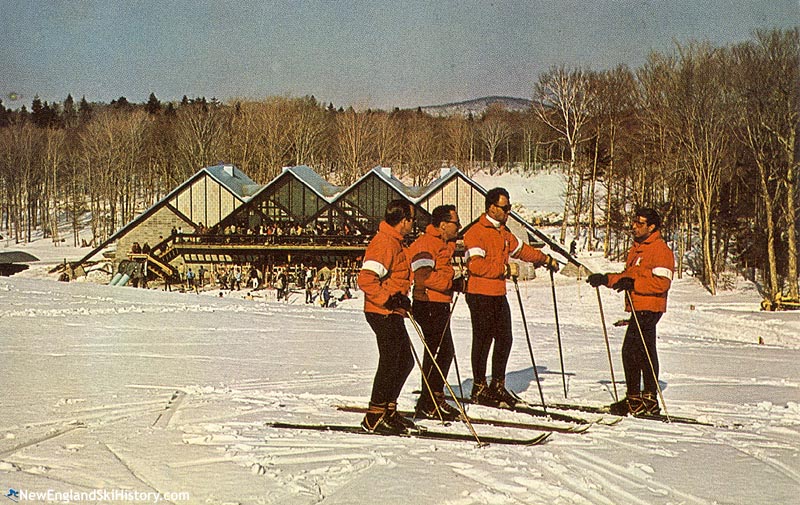
The new Rams Head lodge circa the 1960s |
Ram's Head was formally dedicated on Thursday, January 31, 1963, in conjunction with the airing of Killington's Discover '63 episode on ABC. Already in operation for several weeks, the new Ram's Head lodge included two cafeterias, a rental shop, and a public relations office.
Snowpack continued to build, with Killington advertising nearly 3 to 5 feet of base in early February. At one point during Washington's Birthday weekend, snow drifted so deep that the top of the Killington Chairlift was buried up to the haul rope. The area reported 13,494 skier visits over the three-day weekend, setting a new record. One day later, the main bearing of the new Ram's Head chairlift failed. Employees simultaneously worked four phone lines trying to find specialized parts, eventually locating candidates in Toronto, Detroit, and New Jersey. In the midst of a snowstorm, employees and company shareholders took to the highways to try to meet airplane deliveries. Though one plane delivery was diverted due to the storm, operations manager Paul Bousquet and ski patrol director Dave Wellington were able to make it to Killington with the parts at 4:30 and 6:00 in the morning respectively, allowing the crucial chairlift to reopen less than 24 hours after the equipment failure.
The US Eastern Amateur Skiing Association Veterans Championship race was staged in March 1963 on the Timberline Trail at Ram's Head, with Wildcat founder George Macomber winning the combined title. Reported base depths peaked at nearly four to ten feet before a rainy start to spring ate away at the snow. Skiing was limited to the upper mountain by late April, but a "band of diehard skiers" continued skiing into early May.
Looking for a hedge against lean years while also extending the ski season, Killington invested in a Larchmont snowmaking system for the 1963-64 season. The initial attempts at snowmaking were unsuccessful, as the aluminum pipe installed in the Snowshed area exploded under pressure. Nevertheless, Killington continued to improve the system.
In 1964, Killington nearly exercised an option to purchase nearby Pico Peak.
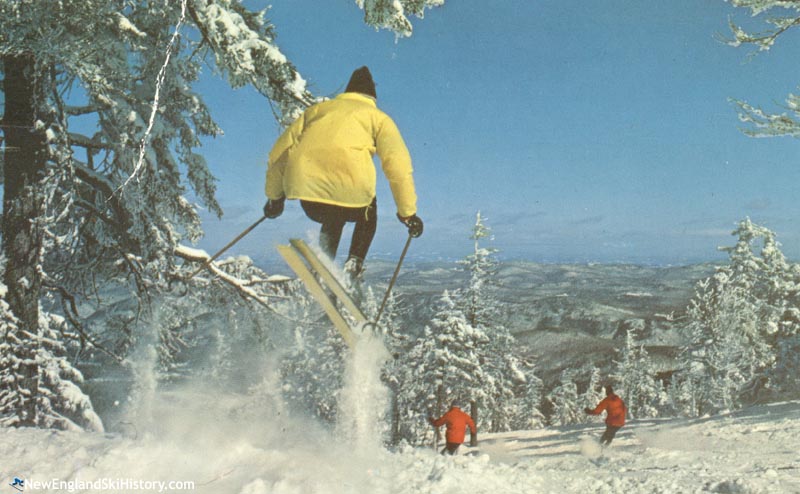
Killington circa the 1960s |
Over the next few years, additional chairlifts were added to existing pods as more and more skiers continued to flock to the resort. In addition, the Killington base lodge was doubled in size for the winter of 1965-66. Revenues reportedly reached $1.5 million that season, which spanned from mid November to mid May for a total of 183 operating days. During the final weeks of the season, skiers carried their skis on the lift to reach the upper mountain snow and had to walk between patches of snow. The season reportedly continued as long as a half dozen skiers would show up, with Paul Bousquet stating, "we'll run until the skiers stop coming."
Killington continued focusing on season length in 1966, putting 400 tons of hay, 2.5 tons of hay seed, and 300 tons of fertilizer down to smooth the slopes. Early snowmaking allowed for October race training and the earliest opening to date (November 5).
As a profitable and growing business, Killington invested in numerous initiatives, such as a news bureau, weekly accounting closes, and analysis of competitors via airplane. All the while, a huge development was in the works for the latter part of the decade.
Onward to Route 4
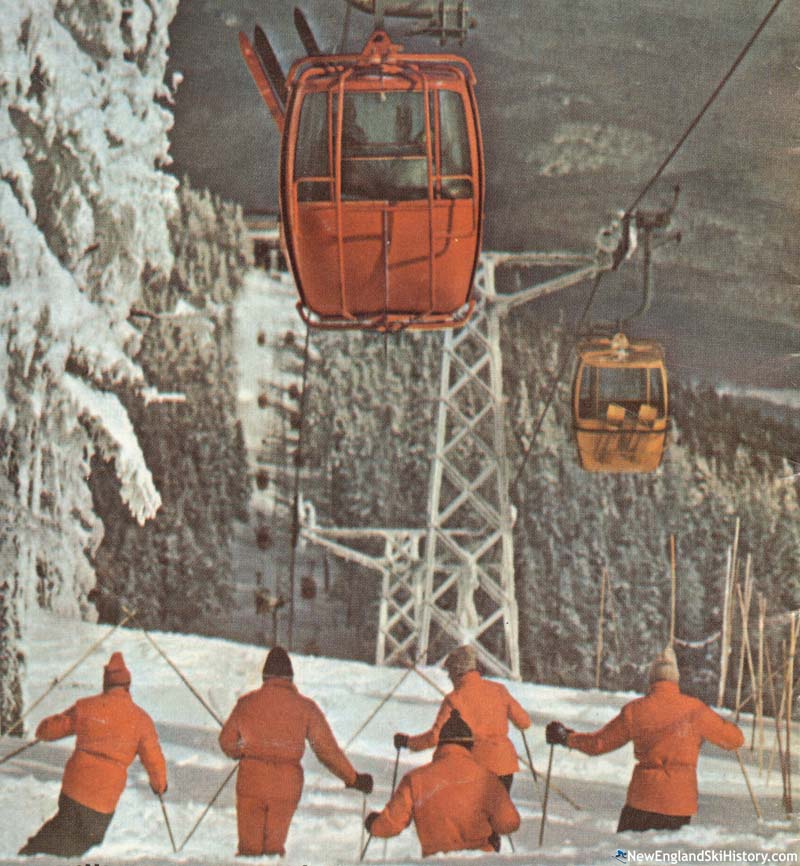
The Killington Gondola circa 1970 |
A multi-year project due to delays in constructing the longest gondola in the world, Killington East opened with lift service during the 1969-70 season. While cost overruns put Sherburne Corporation in financial jeopardy at the time, the project increased the vertical drop by 50% to over 3,000 feet, firmly cementing Killington as the largest ski area in New England.
While Killington's early snowmaking focus had been on the Snowshed area, Pres Smith rolled the dice and installed higher elevation snowmaking on Snowdon for the 1971-72 season. Meanwhile, the first iteration of the Superstar trail debuted. Snowmaking was extended to the summit for the 1972-73 season, paired with the installation of the Glades Triple, the second ever installed in Vermont. Coining a new slogan of "King of Spring," Killington announced plans to offer lift served skiing in June. Though this would not occur for another 10 years, it nevertheless cemented Killington's reputation for offering New England's longest ski season.
Killington continued to expand around the Killington East development later in the 1970s with the addition of the South Ridge and Bear Mountain complexes. Also during the 1970s, the ownership purchased Sunday River and Mt. Snow.
Lift served June skiing was finally achieved 1982, when Killington operated until June 15. For the next two decades, a June closing became the norm.
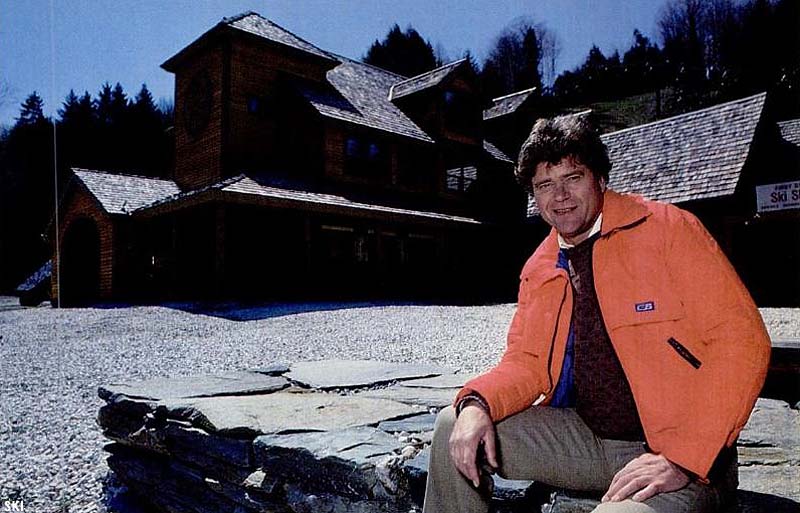
Pres Smith in front of the new Northeast Passage Lodge (1980s) |
Meanwhile, sights were set on Parker's Gore in the early 1980s as Sunrise opened, connecting the Bear Mountain area with US 4 via a 9,243 foot long triple chairlift. Hitting its stride as the middle of the decade neared, Killington was in continuous operation from October 20, 1983 until June 21, 1984, marking 246 consecutive days of skiing.
That fall, S-K-I Ltd. was formed, initially composed of Mt. Snow and Killington. While at the time it seemed liked Killington was on the verge of more big things, that fall also marked the narrow election of Madeleine Kunin as Governor of Vermont. With Burlington Mayor Bernie Sanders set to run against her in 2 years, Kunin quickly found her way onto the pages of the New York Times by going after big ski development, and specifically Killington. At one point, the Governor criticized Killington's water quality record, despite the fact the area had passed all of its state inspections.
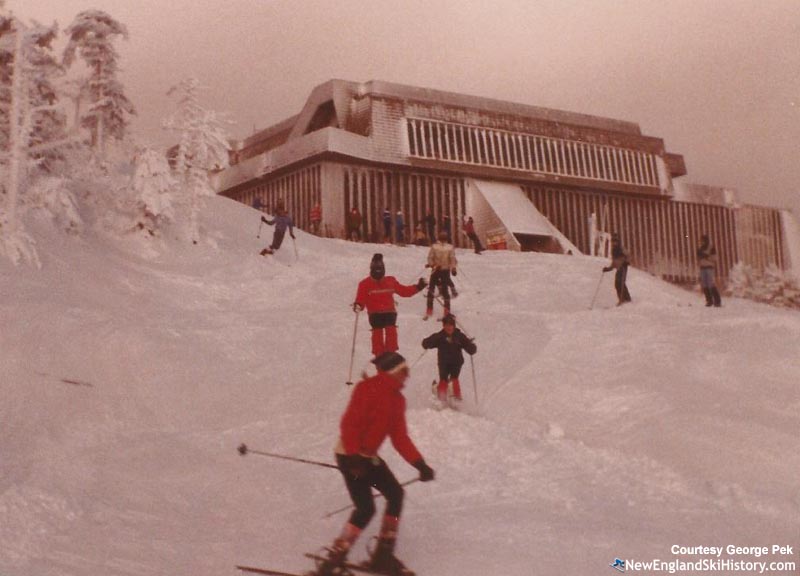
Skiing off the summit (1983) |
As a result of the new road blocks, Killington made no capital investments for the 1985-86 season, ending a decades-long campaign of constant improvements. As Pres Smith told Ski magazine in 1985, "It's a disgrace for Vermont to have government officials say something that isn't even remotely true." Realizing that any significant expansion at Killington was now in jeopardy, S-K-I started to focus on expansion by acquisition. Carinthia was purchased in 1986, followed by what would become Bear Mountain, California in 1988. Three more areas were acquired in the first half of the 1990s.
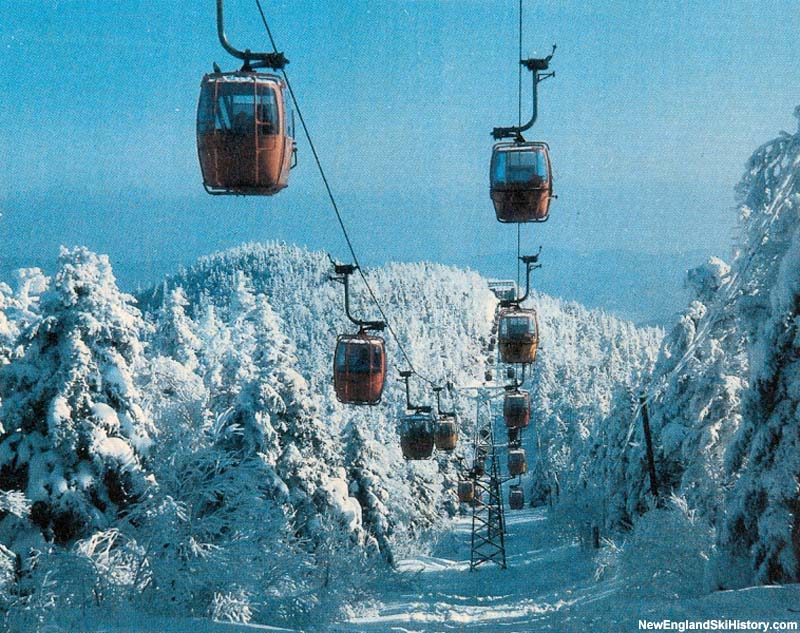
The Killington Gondola circa the 1980s |
Meanwhile, S-K-I continued to stay on the cutting edge of ski technology with its snowmaking, information systems, and lift infrastructure. Killington installed its first two high speed detachable quad chairlifts for the 1987-88 season, followed by its first modern gondola, the Skyeship, in 1994-95.
S-K-I Grows
During this time, S-K-I was involved in an arms race of sorts with former Killington employee Les Otten's LBO Resort Enterprises Corp.. While LBO was quickly acquiring areas, S-K-I purchased ownership stakes in Haystack, Sugarloaf, and Waterville.
The two companies eventually agreed to a merger/buyout in 1996, creating the American Skiing Company
The American Skiing Company wasted no time in making a splash, as it installed three new quad chairlifts during its first year of ownership. Nearby Pico Peak was purchased in 1997, though plans to connect the two have never been completed. Meanwhile, Killington ceded its Parkers Gore holdings in exchange for base area land, the Pico interconnect, and snowmaking water from the Woodward Reservoir.
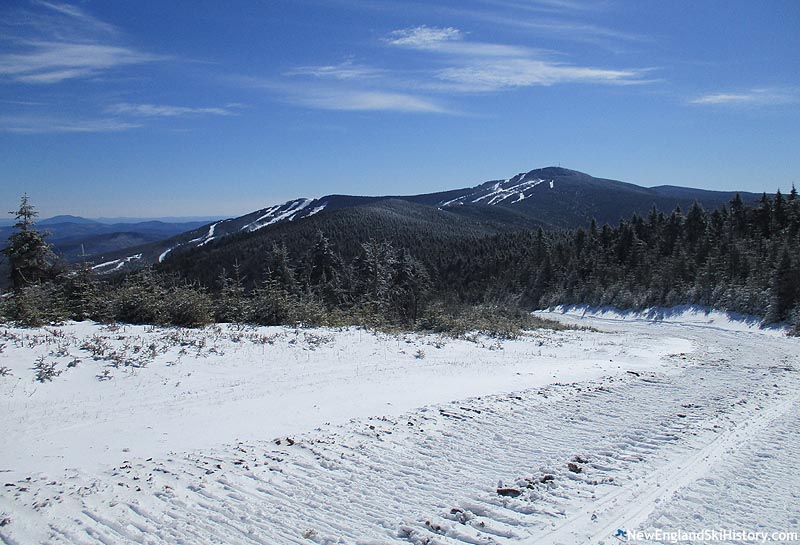
The Pico side of the Interconnect (2016) |
American Skiing Company's Last Run
The American Skiing Company's last new lift investment came in 1997-98, when it replaced the Killington chairlift with the K1 Gondola and retrofitted the Superstar Quad with Poma components. While there was one last victory with the completion of the Woodward Reservoir snowmaking project in 2000, American Skiing Company was drowning in debt, leaving a sea of deferred maintenance behind.
In 2007, Killington was purchased by SP Land Co., with Powdr Corp. taking over operations. The transition was not a smooth one, as controversy was stirred up due to the termination of lifetime passes, as well as the first April closing in over thirty years. Nonetheless, the area saw its first new chairlift in a decade when the Skye Peak Express was installed for the 2008-09 season.
Season length was later addressed when the new Peak Walkway was constructed for the 2010-11 season, providing fall skiers with a foot route between the top of the K1 Gondola and the top of the Canyon Quad and North Ridge Triple. Following the 2010-11 season, Killington announced the replacement of the Peak Lodge. The $7 million project started that off season, as the old lodge was demolished.
On August 28, 2011, Vermont suffered significant damage from Hurricane Irene. In addition to severe road washouts in the area, Killington lost a bar in the base area. Work on the summit lodge was slowed while repairs started elsewhere, including the construction of an umbrella bar to replace the lost building.
Return of the King of Spring
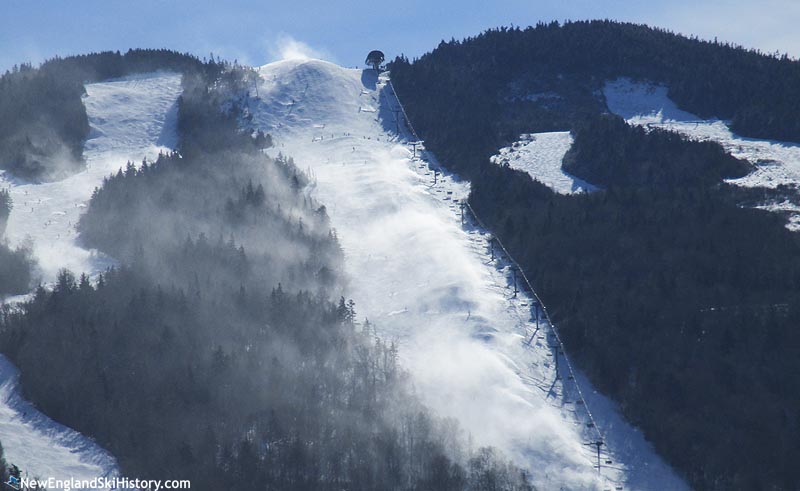
The Superstar Glacier (February 2016) |
After a seven year break, Killington returned to its late season dominance in 2012-13, when it stayed open through May 26. The Robert Carl Williams Associates designed Peak Lodge for the following season.
An expansion of off season activities ramped up starting in 2014 with the debut of lift served mountain biking via the Snowshed Quad. Further attractions were constructed in 2015, including a ropes course, a Soaring Eagle ride, and a mountain coaster.
Killington faced a big challenge in 2016 as it worked to host the first World Cup racing in New England in a quarter of a century. While western ski areas were forced to cancel their World Cup races in November, Killington flexed its snowmaking might by covering the Superstar slope top to bottom in less than optimal temperatures. New England native Mikaela Shiffrin won the Slalom event in 2016 and repeated the feat in 2017 and 2018.
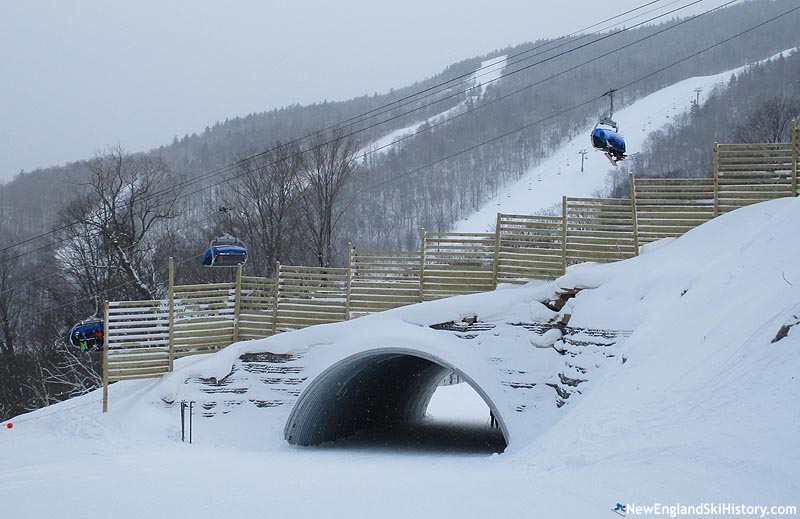
The Snowdon Six Express and lower snow tunnel (December 2018) |
Citing advantages from tax reform, Killington embarked on a $25 million capital improvement campaign in 2018, including a new high speed six person bubble chairlift, two relocated lifts, K1 gondola improvements, snowbridges, RFID, and snowmaking improvements. Despite delays from abundant early season snowfall, the Snowdon Six Express debuted in early December. The South Ridge Quad debuted in February, restoring direct lift service to that trail complex for the first time in nearly a decade.
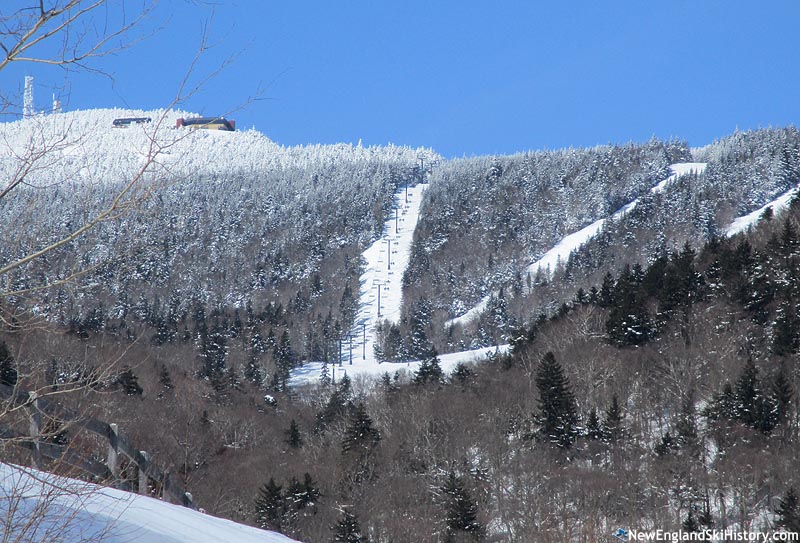
The rejuvenated South Ridge complex (March 2019) |
The big investments continued during the 2019 off season, as the aging early season workhorse North Ridge Triple was replaced with a new fixed grip quad. In addition, work began on a proposed two-year, $27 million replacement of the K1 base lodge. Though Killington was in the midst of a resurgence, COVID-19 brought things to a screeching halt. Not only did Killington have its earliest closing date on record on March 14, but lodge construction was delayed and the 2020 World Cup races cancelled. Ski operations resumed over eight months later, making 2020 the longest off-season of the snowmaking era at Killington.
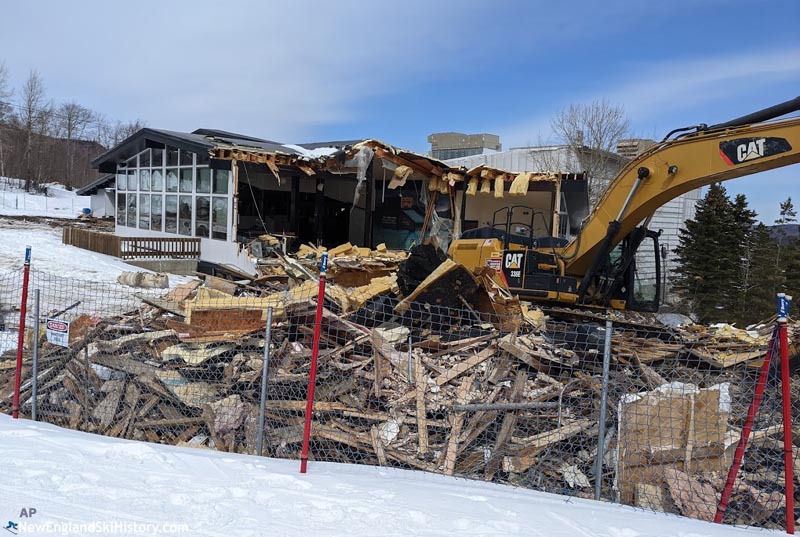
Demolition of the original Killington base lodge (March 2022) |
Delayed due to COVID-19 related struggles, the new K1 base lodge was officially dedicated in late January 2023.
New Ownership
In September 2024, a group of 16 investors named Killington Independence Group acquired Killington and Pico. Powdr Corp. retained a minority stake. Keeping the existing management team, the new ownership group made plans to install 500 new snowguns for the 2024-25 season as part of a planned $30 million, two-year investment program.
The Superstar Express Quad and original Skyeship Gondola carried their last riders in the spring of 2025. The Superstar Express Quad was immediately disassembled to make way for a new high-speed six pack, while a major overhaul of the gondola was planned, complete with new cabins.
NewEnglandSkiConditions.com Reports
| Month |
Average Percent of Terrain Open |
| October | 1% (1 report) |  | | November | 10% (8 reports) |  | | December | 50% (10 reports) |  | | January | 72% (14 reports) |  | | February | 90% (10 reports) |  | | March | 81% (9 reports) |  | | April | 40% (22 reports) |  | | May | 5% (23 reports) |  | | June | 1% (4 reports) |  |
|
| Recent Conditions Reports |
 | Dec. 25, 2025 by nordicgal
Loose Granular, Frozen Granular |
 | Nov. 14, 2025 by alpinevillagepres
Packed Powder, Packed Powder |
 | May. 1, 2025 by nordicgal
Corn, Spring Snow |
 | Apr. 20, 2025 by rocket21
Variable Conditions, Variable Conditions |
 | Apr. 15, 2025 by nordicgal
Variable Conditions, Spring Snow |
|
|
| Killington on NewEnglandSkiConditions.com |
NewEnglandSkiIndustry.com News
| Recent Articles |
| Killington To Replace Snowdon Triple Next Year - Oct. 17, 2025 | | August 2025 Lift Construction Roundup - Aug. 27, 2025 | | Chairlift-Served Ski Season Ends Tomorrow - May. 10, 2025 | | Ski Season Resumes Tomorrow - Nov. 13, 2024 | | Chairlift-Served Ski Season Starts Tomorrow - Oct. 30, 2024 | | Killington Announces Completion of Sale, New Investment - Sep. 30, 2024 | | POWDR Sells Majority Stake of Killington, Pico - Aug. 22, 2024 | | 2023-24 Ski Season Comes to a Close - Jun. 1, 2024 | | Chairlift-Served Ski Season Starts Tomorrow - Nov. 2, 2023 | | 2022-23 Ski Season Starts Tomorrow - Nov. 16, 2022 | | Killington NewEnglandSkiIndustry.com News Page |
Expansion History
Image Gallery
Lifts
Click on lift name for information and photos
Maps
Year by Year History
Adult Weekend Full Day Lift Ticket; Adult Full Price Unlimited Season Pass. Window price, including RFID fee and taxes when known.
| 2020s |
Ticket Price |
Season Pass Price |
Pass Payback |
Opening Day |
Closing Day |
Skier Visits |
| 2025-26 | |  | |  | | November 12 | | |  | | | 2024-25 | $215.94 |  | $1885.74 |  | 8.7 days | November 14 | May 10 | |  | | | 2023-24 | $205.34 |  | $1800.94 |  | 8.8 days | November 3 | June 1 | |  | | | 2022-23 | $200.34 |  | $1705.54 |  | 8.5 days | November 17 | June 1 | |  | | | 2021-22 | $184.14 |  | $1567.74 |  | 8.5 days | November 5 | June 4 | |  | | | 2020-21 | $170.00 |  | $1582.53 |  | 9.3 days | November 20 | May 16 | |  | | | 2019-20 | $130.00 |  | $1336.43 |  | 10.3 days | November 3 | March 14 | |  | |
| 2010s |
Ticket Price |
Season Pass Price |
Pass Payback |
Opening Day |
Closing Day |
Skier Visits |
| 2018-19 | $129.00 |  | $1292.14 |  | 10.0 days | October 19 | June 2 | |  | | | 2017-18 | $115.00 |  | $1261.53 |  | 11.0 days | November 8 | May 26 | |  | | | 2016-17 | $105.00 |  | $1486.23 |  | 14.2 days | October 25 | June 1 | |  | | | 2015-16 | $96.00 |  | $1464.83 |  | 15.3 days | October 18 | May 29 | |  | | | 2014-15 | $92.00 |  | $1443.43 |  | 15.7 days | November 3 | May 25 | |  | | | 2013-14 | $89.00 |  | $1389.93 |  | 15.6 days | October 23 | May 18 | |  | | | 2012-13 | $88.00 |  | $1443.43 |  | 16.4 days | October 13 | May 26 | |  | | | 2011-12 | $86.00 |  | $1443.43 |  | 16.8 days | October 29 | April 22 | |  | | | 2010-11 | $84.00 |  | $1389.93 |  | 16.5 days | November 2 | May 1 | |  | | | 2009-10 | $82.00 |  | $1336.43 |  | 16.3 days | November 7 | April 25 | |  | |
| 2000s |
Ticket Price |
Season Pass Price |
Pass Payback |
Opening Day |
Closing Day |
Skier Visits |
| 2008-09 | $82.00 |  | $1443.43 |  | 17.6 days | November 2 | May 2 | |  | | | 2007-08 | $79.00 |  | $1376.94 |  | 17.4 days | November 16 | April 20 | |  | | | 2006-07 | $72.00 |  | $1400.00 |  | 19.4 days | November 23 | May 6 | 700,000 |  | | | 2005-06 | $69.00 |  | $1300.00 |  | 18.8 days | October 29 | May 1 | 795,000 |  | | | 2004-05 | $67.00 |  | $1100.00 |  | 16.4 days | November 9 | May 15 | 986,000 |  | | | 2003-04 | $65.00 |  | |  | | November 10 | May 12 | 955,000 |  | | | 2002-03 | $64.00 |  | |  | | October 25 | May 26 | 1,045,000 |  | | | 2001-02 | $62.00 |  | $1099.00 |  | 17.7 days | November 6 | June 1 | 953,000 |  | | | 2000-01 | $58.00 |  | $1249.00 |  | 21.5 days | October 29 | May 27 | 1,085,000 |  | | | 1999-00 | $56.00 |  | $1249.00 |  | 22.3 days | October 25 | May 29 | 939,000 |  | |
| 1990s |
Ticket Price |
Season Pass Price |
Pass Payback |
Opening Day |
Closing Day |
Skier Visits |
| 1998-99 | $52.00 |  | $1299.00 |  | 25.0 days | October 22 | May 25 | 978,000 |  | | | 1997-98 | $51.45 |  | $1249.00 |  | 24.3 days | October 1 | May 25 | 1,077,000 |  | | | 1996-97 | $48.00 |  | $1500.00 |  | 31.3 days | October 4 | June 22 | |  | | | 1995-96 | $48.00 |  | |  | | October 17 | June 10 | |  | | | 1994-95 | $46.00 |  | |  | | October 3 | June 4 | |  | | | 1993-94 | $45.00 |  | |  | | October 1 | June 9 | |  | | | 1992-93 | $41.00 |  | |  | | October 1 | June 1 | 972,000 |  | | | 1991-92 | $39.00 |  | |  | | October 21 | June 14 | |  | | | 1990-91 | $39.00 |  | |  | | October 27 | May 28 | |  | | | 1989-90 | $37.00 |  | |  | | October 10 | May 28 | |  | |
| 1980s |
Ticket Price |
Season Pass Price |
Pass Payback |
Opening Day |
Closing Day |
Skier Visits |
| 1988-89 | $34.00 |  | |  | | October 13 | May 21 | |  | | | 1987-88 | $35.00 |  | |  | | October 12 | June 1 | |  | | | 1986-87 | $30.00 |  | |  | | October 10 | June 3 | |  | | | 1985-86 | |  | |  | | October 28 | June 1 | |  | | | 1984-85 | $26.00 |  | $580.00 |  | 22.3 days | November 3 | June 2 | |  | | | 1983-84 | $25.00 |  | $550.00 |  | 22.0 days | October 20 | June 21 | |  | | | 1982-83 | $24.00 |  | $525.00 |  | 21.9 days | October 17 | June 16 | |  | | | 1981-82 | $22.00 |  | |  | | October 20 | June 15 | |  | | | 1980-81 | $20.00 |  | |  | | October 14 | May 27 | |  | | | 1979-80 | $17.00 |  | $397.00 |  | 23.4 days | October 10 | May 23 | |  | |
| 1970s |
Ticket Price |
Season Pass Price |
Pass Payback |
Opening Day |
Closing Day |
Skier Visits |
| 1978-79 | $15.00 |  | |  | | October 16 | May 22 | 676,056 |  | | | 1977-78 | $14.00 |  | |  | | October 24 | May 23 | 698,950 |  | | | 1976-77 | |  | |  | | October 27 | May 15 | |  | | | 1975-76 | $12.00 |  | |  | | October 30 | May 5 | |  | | | 1974-75 | $11.00 |  | |  | | October 19 | May 12 | 440,345 |  | | | 1973-74 | $10.00 |  | |  | | November 5 | April 30 | 341,319 |  | | | 1972-73 | $9.50 |  | |  | | October 20 | April 28 | 382,355 |  | | | 1971-72 | $9.50 |  | |  | | November 9 | May 18 | 448,809 |  | | | 1970-71 | $9.50 |  | |  | | November 18 | May 21 | |  | | | 1969-70 | $9.00 |  | |  | | October 24 | May 4 | |  | |
| 1960s |
Ticket Price |
Season Pass Price |
Pass Payback |
Opening Day |
Closing Day |
Skier Visits |
| 1968-69 | $8.50 |  | |  | | November 9 | May 10 | |  | | | 1967-68 | $7.00 |  | |  | | November 5 | April 7 | |  | | | 1966-67 | $7.00 |  | |  | | November 4 | May 2 | 319,756 |  | | | 1965-66 | |  | |  | | November 18 | May 18 | 321,000 |  | | | 1964-65 | $6.25 |  | $120.00 |  | 19.2 days | November 21 | May 4 | 250,000 |  | | | 1963-64 | $6.00 |  | |  | | December 3 | April 23 | 240,000 |  | | | 1962-63 | $5.75 |  | |  | | December 9 | May 5 | 193,000 |  | | | 1961-62 | $5.50 |  | |  | | December 2 | April 30 | 118,000 |  | | | 1960-61 | $5.25 |  | |  | | December 14 | May 8 | 64,850 |  | | | 1959-60 | $4.50 |  | |  | | December 12 | April 17 | 39,804 |  | |
| 1950s |
Ticket Price |
Season Pass Price |
Pass Payback |
Opening Day |
Closing Day |
Skier Visits |
| 1958-59 | |  | |  | | December 13 | April 16 | 13,000 |  | |
1997-2006 skier visit figures include Pico
Visitor Memories
| "I miss the northeast passage area of Killington. We rented a house across the street and worked at First Stop ski shop.It was the best place to park and start your day. If the peak was 20 to 30 below the passage was the place to be. Great area to start beginners, leave a pack in the lodge, or eat at the Back Behind Bar. I hope that it opens again someday but don't think that will ever happen, too bad for future skiers." | | Chris White, Apr. 22, 2025 | | "Wonderful history of Killington here. My family has roots that go back quite a ways. My mom worked for Joe Sargent in Hartford, Connecticut and Conning & Co. in the 1960s. He offered her a weekend gig promoting the resort by the way of doing ski fashion shows in the southern part of New England. Both my parents were also ski ambassadors there." | | Doug Mahar, Apr. 22, 2025 | | "There was a clinic offered in the 1970s (around Thanksgiving) if you wanted to become a ski instructor. The top handful of attendees were offered instructor positions. That's how I became a ski teacher at Killington and eventually certified at Stowe. Winters were certainly a lot colder back then. I often came back from lessons with frostbite on hands, toes, nose... just part of the job.
Of course, great after ski at the Wobbly Barn and Pickle Barrel.
Not a care in the world." | | William Green, Feb. 11, 2025 | | "That Killington Peak yellow chair was cold! I remember one day in the mid 60s in particular. Great history profile, by the way!" | | Rick Payer, Nov. 15, 2022 | | "First skied here in 64. Tickets were $6.00.
Biggest thing in my young adult life.
Thanks Killington.
" | | William Strait, Dec. 23, 2020 | | "Been skiing killington since early 70's. Best in the east. I've seen a lot of cahnges and most for the best. To many great days and memories with friends and family to list. â›·â›·â„â„🌨🌨ðŸ‘ðŸ‘ðŸºðŸº" | | Leslie Heine, May. 11, 2020 | | "I was director of ski patrol in the late sixties !" | | Ron Thompson, Feb. 2, 2017 | | "Killington has actually offered lift-serviced mountain biking since 1991 on the Killington Double chair and later K1 gondola, making next week's opening the start of the 25th season of mountain biking at Killington!" | | Will Conroy, May. 20, 2016 | | "Monday, Feb 6. I was staying with friends at the Red Rob Inn (now the Killington Mountain School). We sat down for dinner at precisely 6:00 pm and we noticed it just started snowing...slow at first, but within minutes, it was snowing hard. Dinner was over by 7:00; we decided to walk to Charity's for drinks. There was well over six inches of snow on the ground as we walked there. When we left Charity's--around 10:00 pm, there was almost two feet of snow on the ground...and the access road was practically impassable. Cars were stuck everywhere. When we got back to the Red Rob, two ladies who left the hotel earlier that day (to drive home back to Boston)were inexplicably back at the Red Rob. 'Why did you guys return to Vermont?' we asked. 'They closed Massachusetts' was their answer. The turnpike was closed and the Massachusetts police said they would arrest any non-emergency motorists on the highways. When we woke up Tuesday morning, there was almost four feet of snow on the ground. Kenny Budzyna, the co-owner of the Red Rob calmed us down as we were dying to get to the mountain. Kenny advised us to sit tight: 'There's no rush to go the mountain,' he said. 'Too much snow and the lifts aren't open yet...they won't open until after 10 am.' He asked that we dig out our cars and empty the lot of cars so they can plow the lot. We got to the mountain around 10:30 am...and only a few lifts were running. The parking lot at Killington base was barely cleared of snow; just two bays, perhaps. We saw huge piles of snow that were foreign to us...we were amazed at all the snow there, being piled up as they plowed the lot. Killington 'regulars' were commenting that they never ever saw this much snow. They were still sweeping snow off the Killington Double chair. Most lifts sat still, or were moving very slowly so they could clear the mounds of snow off of each chair. The South Ridge triple didn't open until Wednesday...the mid-station two-bull wheel turn was buried in ten feet of drifts! We broke trails and snow all day Tuesday. The mountain was largely empty. Over 48 inches of snow fell. What a change from the icy conditions we experienced earlier that previous weekend. The snow remained excellent all week, through Friday. Boston Logan airport was closed for seven days. Killington remained empty even that following weekend because so many people couldn't get to the mountain. This was the winter of '78 where there were many storms..more than usual. I am told that this was the largest single dump in Killington history. I am glad that I was there...to experience nothing but powder and loose-pack powder day after day. The novice and many intermediate trails were almost impossible to ski until they were groomed...they weren't steep enough. A few trails (Conclusion, for example) had chest-deep snow. It was the most amazing ski day of my life at Killington...I've been skiing there for more than 40 years. Many other reminisce about that storm. I shall never forget the storm of my ski life...Feb 6-7, 1978. " | | Robert Gedzelman, Jul. 8, 2014 |
|
External Links
Killington Resort - official site
Killington Resort - a Skiernet Perspective
Killington Peak - FranklinSites.com Hiking Guide
Killington - Chairlift.org
KillingtonZone.com
|
Last updated: April 22, 2025
|



